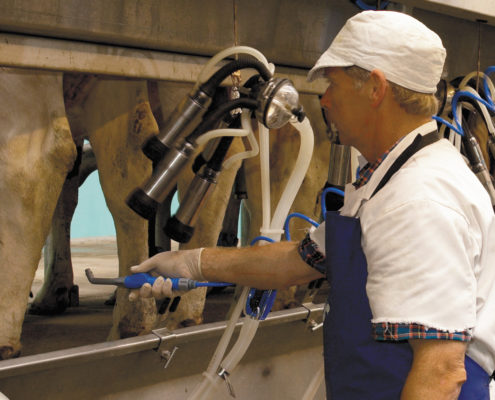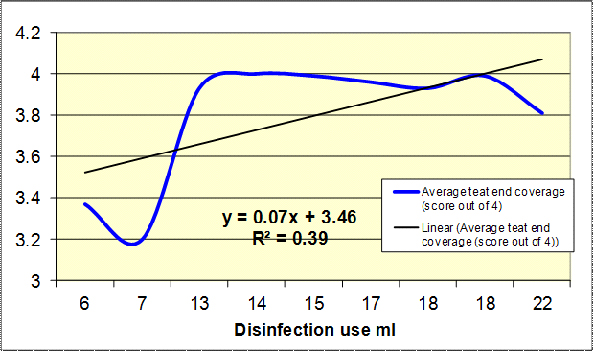How Effective is Post-Milking Teat spraying?
Effective use of a post-milking teat disinfectant was a critical element of the Five Point Mastitis Plan developed by NIRD in the UK in the 1970’s. The importance of good teat barrel coverage with a post-milking teat disinfectant now forms a fundamental part of mastitis control programmes throughout the international dairy industry.
Besides the bactericidalproperties of a post milking teat disinfectant, complete teat coverage with the product is essential to help ensure that the teat skin is kept as soft and supple as possible to withstand the rigors of milking. When teat skin is not in a satisfactory condition, not only is the teat more difficult to clean, it can also harbour bacteria that can adversely affect the keeping quality of milk and increase the risk of mastitis. Added to this is the physical aspect of a liner opening and closing on a teat two or three times each day. Poor skin condition can increase the prevalence of lesions such as hyperkeratosis that impact on milk quality, milking out time and udder health.
Over the years there has been a move away from post dipping to manual teat spraying. This has occurred as herd size has increased while the amount of labour per cow has fallen. Spraying can be carried out more quickly than dipping, but anecdotal evidence suggests that dipping is more effective in achieving better coverage than spraying and is considered to be less operator dependent. In a busy parlour, a quick spray by many operators is considered to be sufficient and is believed to “tick the box” for a mastitis control protocol. In addition there are an increasing number of automatic teat spraying systems available on farm. Ideally an automatic system will provide 100% teat barrel and teat end coverage, after every milking.
In 2013, The Dairy Group carried out on-farm studies, commissioned by Ambic, to measure post milking teat barrel and teat end coverage where the operator was manually spraying with disinfectant, mainly using vacuum operated teat sprayers.
Teat barrel and teat end coverage were assessed post application of the teat disinfectant product on ten farms, each with a minimum of 150 cows. To assess barrel coverage, the front and back of the teat was scored as a maximum of 50, i.e. if all one teat side was completely covered this equated to a score of 50 (100% coverage of that plane), whereas a score of 25 meant that only half of that plane was covered in chemical. If both sides of the teat barrel were completely covered this equated to 100% teat barrel coverage. Teat end coverage was assessed as either covered or not covered (hit or a miss). The volume of teat disinfectant product applied during the monitored milking was measured and a calculation of chemical usage / cow / milking was made.
The study highlighted a wide range in efficiency of teat spraying between farms (Table 1).
On average just over 50% of teat barrels were coated with the post milking teat disinfectant, with the range from 19.8% to 83.4%, with no operator achieving complete teat barrel coverage all the time. Although there was no arithmetic difference in teat barrel coverage between left and right teats, more than half of rear teat barrels were covered with disinfectant compared to less than half for the front teats.
There were also differences in the coverage of the front and rear planes of the teat barrel with disinfectant (Table 2). Just over 80% of the rear of teat barrels was coated with disinfectant in this study but only 40% of the front plane of the teat barrel was covered. Coverage of the front plane of cows’ teats tended to be worse where cows stood at 90° to the operator – such as in rapid exit and external rotary milking parlours.
Only on one farm out of the ten were all teat ends covered with disinfectant (Table 3), arguably the most important part of the teat. The worst farm was covering on average only 80% of teat ends, again highlighting the considerable range in the effectiveness of spraying. There was little difference in the percentage of teat ends covered between teats on the left and right, or front and rear teats.
The quantity of teat disinfectant applied per cow per milking varied from a maximum rate of 21.8ml, which was almost 3.5 times greater than the minimum of 6.3 ml. The average use at 15.3 ml, is in line with often quoted rates. There was no clear relationship between the amount of disinfectant applied and teat barrel coverage, although teat end coverage was worse where low amounts of disinfectant were used (less than 7 ml). Interestingly, there was no apparent relationship between owner and employee operators responsible for teat spraying with regard to volume used or teat end and teat barrel coverage.
Statistically, the data suggests (Figure 1) no strong correlation (R2 = 0.39) between disinfection use and teat end coverage, although good teat end coverage can be achieved with around 14 ml of teat disinfectant. Rates below this threshold lead to increasing numbers of teat ends not having any disinfectant applied. The correlation was even less between the quantity of teat disinfectant used and teat barrel coverage, again indicating the efficiency of the operator is more far more important.
Conclusions
- There is a significant range in the skill with which post milking teat disinfectants are applied with a hand held, vacuum operated teat sprayer.
- The level of variation in applying post-milking disinfectant confirms on many farms the objectives of teat spraying are not being achieved.
- The majority of mastitis control programmes and protocols in place involve complete post-milking teat disinfection.
Table 1. Teat end and teat barrel coverage with disinfectant
|
Teat end coverage (average number of teat ends) |
Average percentage cover of teat barrel |
|||||
|
Left teats |
Right teats |
Rear teats |
Front teats |
All teats |
||
|
Study average |
3.77 |
50.1 |
50.5 |
52.4 |
48.2 |
50.3 |
|
Minimum |
3.2 |
18.7 |
20.9 |
20.6 |
18.9 |
19.8 |
|
Maximum |
4.0 |
82.3 |
85.1 |
86.2 |
80.6 |
83.4 |
Table 2. Teat barrel coverage
|
Rear Left |
Front Left |
Front Right |
Rear Right |
|||||
|
Back |
Front |
Back |
Front |
Back |
Front |
Back |
Front |
|
|
Average teat coverage (score out of 50) |
42.9 |
21.9 |
42.0 |
17.5 |
42.1 |
18.5 |
43.3 |
21.9 |
|
Number of teat barrels with no coverage |
7.1 |
40.9 |
8.3 |
60.2 |
6.6 |
58.2 |
6.2 |
42.7 |
|
Average number of teats scored (excludes cows with missing teats) |
166.1 |
165.7 |
166.0 |
166.4 |
||||
Table 3. Percentage teat end coverage
|
Rear Left |
Front Left |
Front Right |
Rear Right |
Average |
|
|
Teat end only covered |
95.5 |
92.2 |
94.2 |
96.2 |
94.5 |
Figure1. Disinfectant use and teat end coverage




